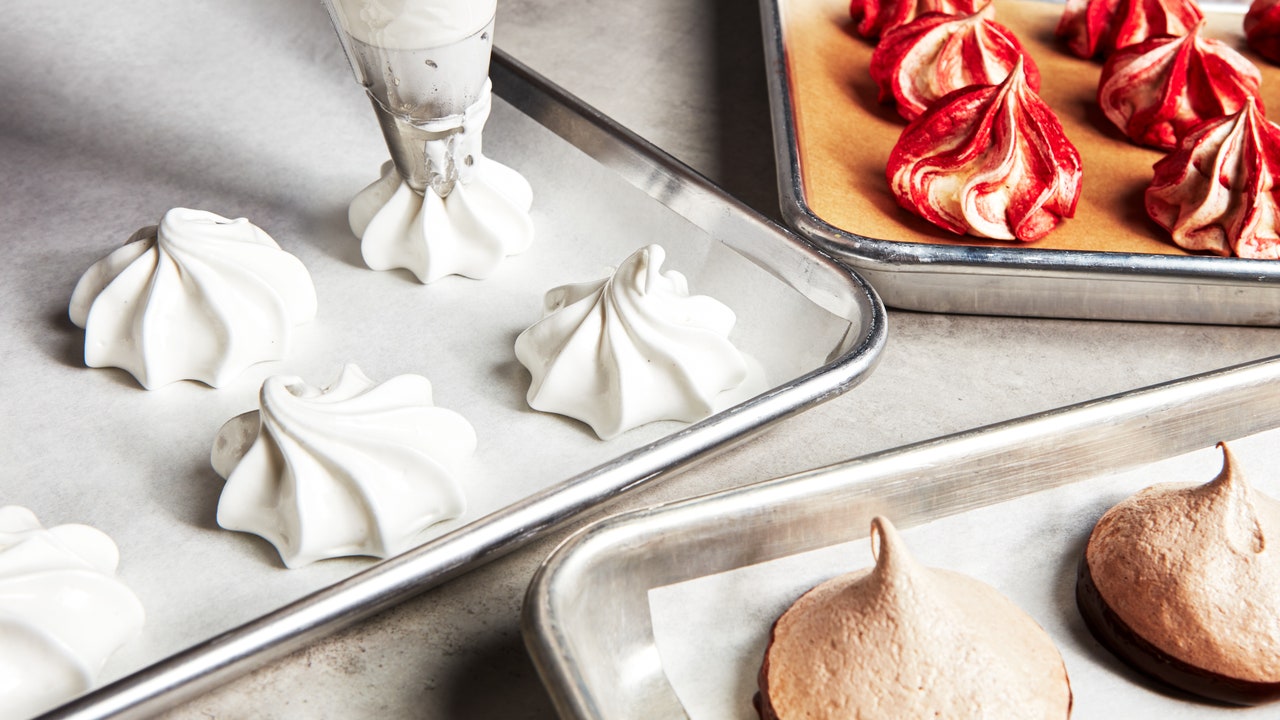How to Pipe, Stripe, and Dip Meringue Cookies Like a Pro
When I worked as a pastry chef, the task I most looked forward to each night was making a batch of meringue. The process of whipping egg whites into a fluffy, shiny cloud never ceased to amaze me. At work I used the sturdy marshmallow-like meringue to top pies or frost cakes, but at home I baked batch after batch of meringue cookies.
I first fell in love with crisp, light-as-air meringue cookies through my mom. A true meringue fiend, she kept tubs of the Trader Joe’s vanilla meringues stocked in the cabinet at all times. As a kid, I loved how the near-weightless cookies dissolved on my tongue, like the freeze-dried astronaut ice cream I constantly begged for. I inherited my mom’s love for meringues, but I’ve still never met anyone who adores these cookies quite as much as she does.
The problem: Meringues are notoriously finicky to make from scratch. My mom attempted to bake them many times, and no matter how good they looked when they went into the oven, her meringues would always end up melting into a pool of frothy sugar on the baking sheet. When I became a professional baker, my mom had one request: I needed to learn how to make meringues.
In developing three new meringue cookie recipes, my goal was to provide all of the tips and tricks needed to set up even baking novices for success. Whether you want classic vanilla bean, swirly peppermint, or double chocolate, these meringue cookie recipes will help you hone your pastry skills.
Armed with these reliable base recipes, I now bake my mom a different flavor of meringues for every holiday. For this past Mother’s Day, I baked vanilla-rose meringues, dusted with rose petal powder. For her birthday, I presented lavender meringues alongside the cake, and for Hanukkah, these chocolate-dipped ones are far more valuable than gelt. Packaged in a cute tin, they make a fantastic gift, especially since these cookies last at room temperature for 2 weeks.
How to make perfect meringue:
Whenever you’re making meringue, it’s important to start with a clean, dry mixing bowl. Any lingering moisture or trace of fat can prevent the egg whites from whipping. Eggs are easier to separate when cold, but easier to whip at room temperature. That’s why I like to separate my eggs straight out of the fridge, then let the whites sit in the mixing bowl on the counter while I measure the rest of the ingredients.
Some meringue recipes warn you against overwhipping the egg whites, which causes them to deflate and turn foamy. You don’t have to worry about that with these recipes, though: Cream of tartar prevents the egg whites from overwhipping, so you can take the meringue to very stiff peaks without risk of collapse.
The meringue should be shiny, billowy, and marshmallow-like, holding the shape of the beaters. To test if the meringue is done, remove the whisk attachment—the meringue on the whisk should stand up straight, only drooping ever so slightly.
How to pipe meringue kisses:
For the prettiest meringues, you’ll want to use a pastry bag fitted with a piping tip. To fill the pastry bag easily, lower it into a tall glass or vase and fold the edges of the bag over the rim.
This recipe makes about 30 two-inch meringues, but you can customize the size. I like to make tons of tiny meringue kisses to decorate cakes or fill a cookie box with confetti-like bites.
How to make colorful striped meringue cookies:
If you love a good art project, this recipe for peppermint meringues is for you. Striping the inside of the piping bag with food coloring results in pretty candy-cane-like meringues, with the flavor to match from a hint of peppermint extract.
To stripe the inside of the piping bag, you’ll want to use a very thin paintbrush. Squeeze a few drops of food coloring into a small bowl, then dip the paintbrush in and pipe four thin, equally spaced lines up the inside of the piping bag.
How to make meringue cookies without a piping bag:
Don’t have a pastry bag? You can still make these meringue cookies. For a more rustic look, use a two-ounce cookie scoop or two spoons to dollop the meringue into small mounds on the baking sheet.
How to dip meringues:
Flavored with a smidge of cocoa powder, these chocolate meringues look and taste just like the top of a Wendy’s frosty. Dipping the bottom third of the meringues in melted chocolate heightens the cocoa flavor and gives these meringues an extra-elegant look.
How to store meringues:
Baking meringues at a low temperature for a long period of time essentially dehydrates them, resulting in crisp, airy cookies. When stored properly, meringues last for up to two weeks. Store them in an airtight container at room temperature, ideally with a few silica packets.
```
